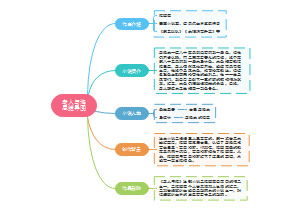导图社区 名词
- 639
- 44
- 12
- 举报
名词
名词总结大纲总结,后续补充句式用法
编辑于2020-01-28 04:49:25- 相似推荐
- 大纲
名词
所有格
所有格表示所有关系的形式,汉语中常用 某人(物)的··· 来表示
's 所有格
1.在单数名词和非-s结尾的复数名词后面加上 's 如: mother's room men's work the people's right 人民的权利 2.在以-s 和 -es 结尾的词后面只加 ' 如: workers' restroom员工休息室 the ladies' room 女厕所 3.复合名词的所有格,在后面的名词结尾加 's 如: son-in-law's telephone number 女婿的电话号码 the brother-in-low's photo 他姐(妹)夫的照片 4.如果一个东西为几个人所共有的,则在最后一个名词结尾加 's,如果是每个人各自的,则在每个名词结尾加 's 如: Li Ming and Wang Mei's bicycle Li Ming's and Wang Mei's books 5.'s 所有格的用法 1> 主要用在人或有生命的名词 cow's milk 牛奶 2> 用于人组成的集体名词 the Party's call 党的号召 the People's Republic of China 中华人民共和国 3> 用于地区、国家、城市等名称的名词 the earth's surface 地球表面 the city's museum 城市博物馆 4>用于表示时间、距离的名词 a week's holiday 一周的假期 ten minutes' walk 10分钟的路程
这两者的关系
1.这两者常可以互换,且意思不变: 例如: children's books = the books of children 儿童用书 Lei Feng's diary = the diary of Lei Feng 雷锋日记 2.但有些情况下只能用 of 短语 ,不能用 名词所有格形式 1.表示所有关系的名词本身带有后置定语 例如: I know the name of the girl sitting by the door 2.表示的所有关系的名词较长时: 例如: the founding of the People's Republic of China 中华人民国的成立 3.of短语表示的是所修饰名词的具体内容或材料时 例如: a ring of gold 金戒指 a map of world 世界地图
of所有格
1.of短语主要用在无生命的所有关系 如: the title of the book 书名 the door of the room 房门 2.有时也用在有生命的东西 如: the duties of the monitor 班长的职责 a pupil of the famous teacher 那位著名教师的学生
双重所有格
双重所有格由 of + 's 或者 of + 名词性物主代词 构成,意思为 “其中之一”或“其中的一部分” 例如: an old friend of my dad's 我爸爸的一位老朋友 a funny story of hers 她的一次有趣经历 (hers是名词性物主代词) 再例如: a photo of my aunt's 和 a photo of my aunt 是两个意思 前一句表示我姑姑拥有的一张照片,不一定是我姑姑本人的照片 后一句表示我姑姑本人的照片
数
可数名词
可数名词有单复数之分 单数就是名词原形 复数多词尾变化 a pen a child many children
词尾直接加s
s,x,ch,sh后面直接加es,以e结尾的加-s
但是ch发音为/k/的,加-s class-classes box-boxes watch-watches stomach-stomachs
以f,fe结尾的,把f,fe变为v,在加-es
例如: life-lives 生命 leaf-leaves 树叶 但有些后面只加s,如: roof-roofs 屋顶 chief-chiefs 头领
以辅音字母加y结尾的词,把y变为i再加-es
例如: baby-babies city-cities story-stories
以o结尾多数的后面加es
如果是有生命的,多数词尾加-es,例如: tomato-tomatoes 番茄 potato-potatoes 马铃薯 hero-heroes 如果是无生命的,多数词尾加-s,例如: photo-photos piano-pianos bamboo-bamboos 竹子
不规则变化
1.单复数同行的单词 sheep-sheep deer-deer fish-fish 2.有些名词变复数时,元音字母发生变化 foot-feet goose-geese 鹅 man-men 3.有些以词尾加-en构成的 child-children ox-oxen 公牛 4.表示某国人的复数形式有以下三种 1>单复数同行 Chinese-Chinese 2>词尾加-s an American-two Americans a Russian- two Russians 3>词尾变man为men的 an Englishman-two Englishmen
复合名词的变化
复合名词变复数 1.将主体名词变复数 new-comer -- new comers 移民者 son-in-law -- sons-in-law女婿 2.无主体名词的,在词尾加-s grown-up --grown-ups 成年人 3.以man或woman开头的词,要前后都变复数 man doctor -- men doctors
名词单复数使用的注意
1.有些名词总以复数形式出现 clothes scales天平 trousers 裤子 jeans 牛仔裤 glasses 2.有些物质名词和抽象名词也以复数形式出现,但是意思就变了,所指的范围也变小了 water - waters 水域 time - times 时代 green -greens 蔬菜 custom 习惯 -customs 海关 3,专有名词一般只用单数,有时也用复数,相当于普通名词 There are four Wangs in our class 我们班有四个姓王的 4.在做定语的合成词中,名词要用单数形式 a two-year-old boy 一个两岁的男孩 a six-million-word book 一本六百万字的书
不可数名词
不可数名词一般用 数词 + 量词 + of + 名词 的变化形式表示 ,类似于 :一块肥皂 a piece of paper a cake of soap 一块肥皂 a glass of water a cup of tea
以-ies结尾的学科的名词常用作不可数名词
如: physics mathematics polities
表示复数用 数词(或不定冠词)+量词+of+名词
如: a cup of tea a piece of paper a large sum of money 一大笔钱
分类
普通名词
可数名词
个体名词
表示单个的人或者物,如: Driver Apple
集体名词
表示一群人或一些事物的集合体,如: family 家庭 staff 全体
不可数名词
物质名词
不能用个体表示的物体或材料等,如: money water
抽象名词
表示动作、状态、心情等的词,如: love friendship
专有名词
表示特定的人、地点、组织机构、国家、季节、部门、称呼等 1.专有名词的首字母要大写,如: Marx 马克思 Africa 非洲 2.如果是冠词或者介词开头首字母无须大写
句式用法
主语
表语
宾语
宾语补足语
定语
同位语
状语









